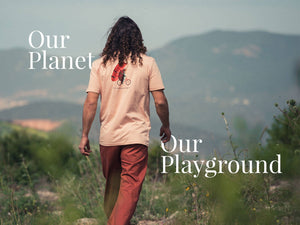Jan 14, 2024
Durable, sustainable activewear: How outdoor kit has changed over time.
A brief history of climbing and mountaineering kit
Nowadays we've got access to countless brands offering a variety of specialised mountaineering and climbing gear, but it wasn't always this way. Early mountaineers, who often engaged in alpine pursuits for scientific exploration or local cultural reasons rather than recreational purposes, wore practical clothing suited to the harsh mountain environments.
Lowell Smith, a member of the moutnain rescue team in Oregon, checking is bearings. Photographed for Summit magazine in 1959 by David Falconer
19th Century: Tweed, wool, and knee length skirts...stylin'
- In the 19th century, as mountaineering gained popularity in Europe, mountaineers often wore layers of wool and tweed - stuff you can now get from the Thrift Shop down the road! 🎵 These materials provided some insulation and protection against the cold weather.
- Heavy, long skirts and dresses were common for women mountaineers during this time, reflecting the conservative Victorian fashion...we've not seen that come back into fashion just yet, but who knows...maybe we'll be the trendsetters!
Early 20th Century: Waterproofing and your great great grandad's crampons
- As technology advanced, mountaineering kit started to incorporate new materials such as gabardine (tightly woven fabric to provide waterproof properties) and canvas. These fabrics offered improved durability and weather resistance to help battle off the harsh elements old school mountaineers had to face.
- Leather boots with hobnails on the soles became popular to help provide better grip on rocky surfaces.
Mid-20th Century: The age of the Synthetic Fabrics and Functional Design
-
By the mid-20th century, mountaineering saw the introduction of synthetic fabrics like nylon and polyester, offering better water resistance than traditional materials.
- The design of mountaineering gear became far more focussed on functionality, with features like reinforced knees and elbows for durability, as well as ventilation zippers to help regulate body temperature. Features we still use today in our activewear.
Late 20th Century: When science met clothing
- Advancements in the late 20th century led to the development of specialised mountaineering gear. TGchnologies like Gore-Tex, a waterproof and breathable fabric, became widely used for outer layers, providing protection against the elements.
- Insulating layers made of materials like down and synthetic insulation improved warmth without adding excessive weight. Goodby tweed jackets, hello Down Jackets and toasty winter fleeces!
21st Century: Innovation, Performance, and importantly...SUSTAINABILITY (you're welcome 😉)
- The 21st century witnessed a huge surge of innovation in mountaineering and climbing attire, with an emphasis on lightweight and high-performance materials.
- Performance became a given, with so many brands offering top quality activewear adventurers have become spoilt for choice. But a new priority moved up the list...the environment! Recycled materials, vegan fabrics and organic cottons became a must-have for many adventurers, after all...if we don't look after the environment, we won't have anything to explore!
So, what goes into sustainable activewear?
With more and more people making the most of the great outdoors, the need for activewear has grown massively. Along with the higher demand comes cheaper and irreponsible maufacturing. But not all activewear is built the same - enter...3RD ROCK 💪
There's a lot to consider when making sutainable eco activewear: Materials, dyes and printing, manufacuring ethics, packaging, carbon output/offsetting. Take a look at at our sustainability page to learn how we treat our planet right.
Sustainable, looks great, feels great...what's not to love? 👖
The Eco credentials of the EcoMORPH Denim are very exciting indeed. Not only is it made from GOTS (Global Organic Textile Standard) certified Organic Cotton, the high tech, state of the art processing systems used for washing and finishing the garments actually eliminate all the key environmental issues from our denim processing. This is High tech eco denim right here!
Our denim is finished using the Jeanologia production process. The facility we use is one of only 6 in the world that offer this green denim technology. Aniline free indigo (The 1st sustainable indigo by Archroma!) was also used to colour this 3RD ROCK DENIM collection.
- Light and Raw wash denim garments use the Jeanologica E-flow system alongside the Laundry 5.0 waterless washing technology to achieve the colour through laser machine and ozone washing
- Reduces water use by 85% (using only one glass of water per jeans)
- ZERO Discharge - we guarantee zero contamination eliminating discharge of chemicals into the water supply.
- Recycles the 20 litres of water used in the process.
- Ozone washing saves 62% energy
- Zero Bleach used - It's washed by the atmosphere
- Zero stone / no pumice used
- Zero PP spray (Potassium Permanganate)
- All above energy & resource savings contribute to the washes Green EIM score (Environmental Impact Measurement) software that measures the environmental impact within the garment finishing industry.
- Mid wash denim garments use the ‘Eco Green’ washing process Jeanologic E-flow system alongside Yilmak’s rainforest system.
- The Jeanologica E-flow system saves up to 95% water, 40% Energy & 90% chemicals
- Rainforest finishing reduces water use by over 50% (from normally 12 litres per load to 5 litres per load) and therefore 50% less energy for steam production.
- Zero stone / no pumice used
- Zero PP spray (Potassium Permanganate)
- All above energy & resource savings contribute to the washes Green EIM score (Environmental Impact Measurement) software that measures the environmental impact within the garment finishing industry.
- The Facility that produces these denims plants 5000 trees a year and recycles up to 20% of waste materials
- They are also SEDEX audited


